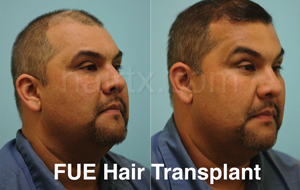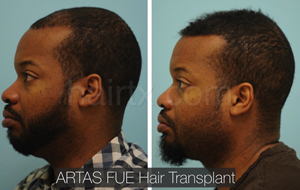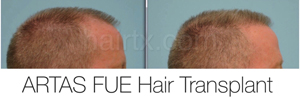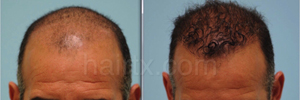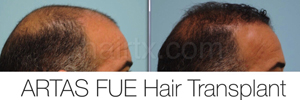FUE (Follicular Unit Excision)
FUE stands for “Follicular Unit Excision” and has become the most prominent trend in the hair-transplant field in the past decade. Dr. Lam has just published the first and only major textbook on FUE (Jaypee Brothers Medical Publishers, 2016).
Contact Us Today! Read Our Manifesto Visit Our Gallery
Virtual Consults

“Dr. Lam’s FUE Textbook, The First and Only Major Textbook Written on FUE”
Follicular units, the naturally occurring hair groupings are individually harvested and the harvest sites are often healed with tiny, almost undetectable scars. The capability to have a hair transplant and wear a short hairstyle is one of the major reasons to consider an FUE procedure.Except some rare and small cases such as using an FUE method to perform a scar repair the hair in the donor area is trimmed very short. Sporting a short hairstyle before and after the procedure can allow for smoother recovery. Within a few days as the healing is completed, the hair in the donor area usually grows back to its original hair length/hairstyle without disturbing one’s social life. However, it is important to distinguish this capacity from being able in the future to shave one’s head completely, because at times, the healed areas can look like white dots (medically known as hypopigmentation) which can be visible if the hair is completely shaved. Further, if the donor area is very thin and scalp can be seen through hairs even before any surgery, then a strip donor harvest should not be undertaken and FUE donor harvesting would most likely be the ideal method for that person.
Other benefits of the FUE technique are that hair transplant can be possible for patients who are not good candidates for strip procedures due to loss of scalp laxity or due to the lack of scalp donor hair.For example, if someone has a very tight scalp, in many cases due to numerous previous strip procedures, FUE may be the only method that is safe to perform a hair transplant for that individual. Sometimes individuals who have had prior strip procedures are relatively tight in the occipital scalp (in the middle of the back of the head) but not in the temporal areas (sides of the head) and FUE can be performed in the central portion and an FU-strip can be performed on the sides in a combination procedure. FUE is particularly good as a technique for harvesting in situations when an FU-strip procedure is unfavorable. For example, the nape of the neck is prone to scarring and can only be harvested with FUE. This area can be good for individuals who have very coarse hair and require fine hair for the hairline, but these hairs can only be used in individuals with a stable hair-loss pattern in this region since hair can be lost back upward from the neck area over time. There are many creative solutions to achieve maximal transplantable results as rapidly and as safely as possible. When other sources of donor hair are considered, such as bead or chest hair, an FUE is the only harvesting method available to obtain hairs from non-scalp regions that cannot undergo a linear incision due to the risk of scarring. FUE has become a versatile and excellent method for hair transplant when performed in experienced hands.With that in mind, it can either be used in isolation or in combination with FU-strip harvesting tailored to a particular patient’s needs.


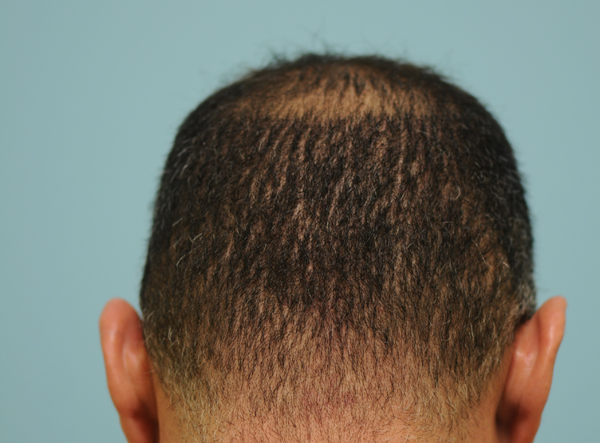
Patient shown before and after FUE procedure. He has very thin hair in the back that makes him an unsuitable candidate for strip procedure due to risk of seeing the incision. With limited donor hair, he is able to achieve good improvement but not total hair density after one session.
Dr. Lam can offer you the most comprehensive consultation to achieve your best outcomes possible that are tailored to your desires and anatomic condition. In certain situations,Dr. Lam still believes that FUE is not suitable for some men and almost all women who often wear a long hairstyle because of the need to shave one’s head before undergoing FUE. A microscopic analysis and discussion with Dr. Lam will help you decide whether this method would be suitable for achieving your aesthetic goal.
Key Points
- Ideal candidate
- Men who have hair loss and are diagnosed with male-pattern hair loss
- Men whose hair-loss progression is relatively slow and stable
- Men who wear their hair very short, have very sparse donor hair, or have donor hair that grows at an obtuse angle (such as some Asian hair) in which the scar would not be well camouflaged
- Men who can comfortably shave their head for the procedure
- What to do
- Schedule your procedure and plan on one week for recovery during which you are functional but may not be socially presentable for 3 to 5 days.
- Cut your hair a day or two before the procedure; you should ask for a “high and tight” hair cut that leaves the top as long as you desire but the sides are cut to a “0” guard.
- If you are not already on any hair-loss management therapy and you have miniaturized hairs, you may be required to start one or several (such as finasteride, minoxidil, and/or laser) in preparation for the procedure. Depending on your unique situation, you may be required to be on a hair-loss management treatment for anywhere between 4 to 6 weeks in order to strengthen your hair and to minimize postoperative, temporary hair shock loss.
- If you are from out of town, you will be required to arrive the day before the procedure and will be allowed to travel the day after, staying in town for a total of two nights.
- What to expect
- You may have visible scabs around transplanted hairs and around harvested sites for about 7 days. You may have swelling of your forehead and around the eyes that may last 3 to 5 days.
- You can wear a hat immediately after the procedure, and you can wash your hair 24 hours after and resume most physical activities 48 hours afterward. You can travel the next day.
- You can wear hairstyling products 2 days after, camouflaging products 7 days after, and color your hair 15 days after the procedure.
- Transplanted hairs should oftentimes start growing 3 to 4 months post-procedure, achieve visible change in many cases at 5 to 6 months post-procedure, and continue improving in growth up to 12 months post-procedure or longer.
Contact Our Office
If you’re interested in learning more about the FUE hair transplant technique in Dallas, TX, contact our office to schedule an informative consultation with Dr. Sam Lam. He will help develop a customized treatment plan to address your specific needs and guide you throughout the entire process.
FAQs
-
I understand that FUE is a scarless procedure. Is that true?There is a misconception that FUE is a scarless procedure. It is worth mentioning that any surgical procedure leaves a scar, and most scars heal with less pigment than in normal surrounding skin (whiter in color). Consequently, even the scars from FUE procedures can be easily noticed as white dots if the scalp is completely shaved. In addition, over-harvesting, which may happen in a single or multiple procedures can result in thinning out the donor hair at the point of looking unnatural. For that reason, it is important to limit the number of grafts in a single session and the total number of grafts in multiple sessions, in order to properly space out the harvest sites and thereby protect the donor area from becoming unnaturally thin.
-
What are the limitations of an FUE procedure?First, FUE grafts are not as hearty as FUT (strip) grafts because they are more fragile, thinner, and have less adnexa (surrounding support structures). Therefore, there is a slightly lower survival rate than FUT. Dr. Lam believes that the gentle handling he and his team perform on his grafts and the regenerative medicine techniques (PRP, ACell, ATP, and HypoThermosol), which he likes to explain as fertilizers, that he uses help to ensure that his FUE grafts grow better than elsewhere in the industry. He also minimizes the ex vivo time (time out of body) by staging transplantation (what is removed is then placed as quickly as possible), and the ARTAS robot, which allows more rapid harvesting, can further minimize ex vivo time of harvested grafts. Second, FUE cannot reasonably provide the same complete front-to-back coverage as FUT can achieve due to donor depletion (there are more total usable FUT grafts in the donor area). Over-harvesting in the donor area with FUE can lead to devastating patchy or moth-eaten scars that are virtually impossible to correct, and in Dr. Lam’s opinion can be far worse than linear strip scars in their appearance and the possibility to correct them.
-
How does Dr. Lam decide to use ARTAS robotic FUE versus a manual motorized or dull punch?The ARTAS provides very precise, controlled harvesting that is also remarkably fast. However, the ARTAS at times has difficulty with certain hair types (very curly or very low angled) and in certain areas of the scalp (like the very low portion of head above the neck or the sides of the head above the ears), so Dr. Lam may supplement the harvest with handheld motorized techniques. For the beard and chest areas, the ARTAS cannot be used, so he harvests these areas with handheld FUE tool that is very accurate and is the only way to harvest from these areas.
 Lam Institute For Hair Restoration
Lam Institute For Hair RestorationVideos
Photos
For more FUE (Follicular Unit Excision) Before & After Photos, Click here
Please watch Dr. Lam’s SlideShare presentation on his philosophy, strategy, and design for crown hair transplantation.
Please watch Dr. Lam’s SlideShare presentation on the fundamentals of male hairline design.
Please watch Dr. Lam’s SlideShare presentation on recipient site design and distribution.
Please watch Dr. Lam’s SlideShare presentation on temporal point reconstruction.




